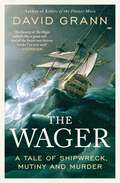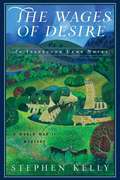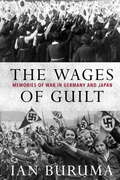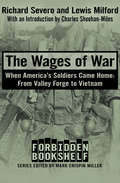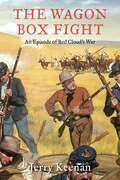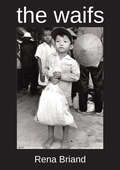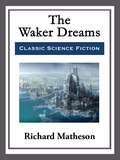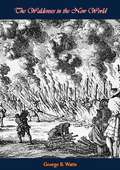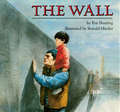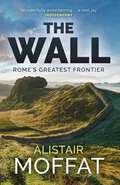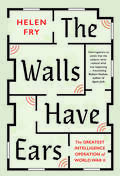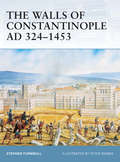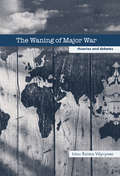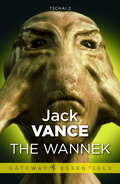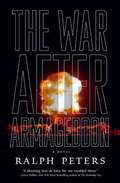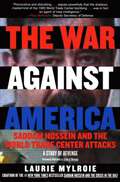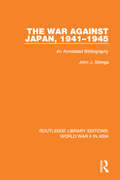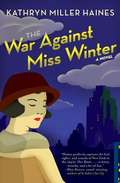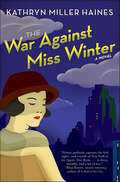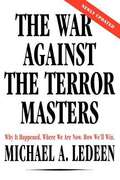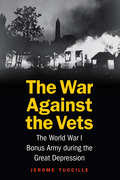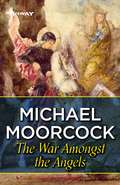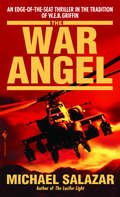- Table View
- List View
The Wager: A Tale Of Shipwreck, Mutiny And Murder
by David GrannTHE SUNDAY TIMES NUMBER ONE BESTSELLER *LONGLISTED FOR THE 2023 BAILLIE GIFFORD PRIZE FOR NON-FICTION* 'The beauty of The Wager unfurls like a great sail... one of the finest nonfiction books I&’ve ever read' Guardian &‘The greatest sea story ever told&’ Spectator'I cannot think of anyone who would not love this book . . . It is an extraordinary true story, beautifully written' Richard Osman&‘A cracking yarn… Grann&’s taste for desperate predicaments finds its fullest expression here&’ ObserverFrom the international bestselling author of KILLERS OF THE FLOWER MOON and THE LOST CITY OF Z, a mesmerising story of shipwreck, mutiny and murder, culminating in a court martial that reveals a shocking truth. On 28th January 1742, a ramshackle vessel of patched-together wood and cloth washed up on the coast of Brazil. Inside were thirty emaciated men, barely alive, and they had an extraordinary tale to tell. They were survivors of His Majesty&’s ship the Wager, a British vessel that had left England in 1740 on a secret mission during an imperial war with Spain. While chasing a Spanish treasure-filled galleon, the Wager was wrecked on a desolate island off the coast of Patagonia. The crew, marooned for months and facing starvation, built the flimsy craft and sailed for more than a hundred days, traversing 2,500 miles of storm-wracked seas. They were greeted as heroes. Then, six months later, another, even more decrepit, craft landed on the coast of Chile. This boat contained just three castaways and they had a very different story to tell. The thirty sailors who landed in Brazil were not heroes – they were mutineers. The first group responded with counter-charges of their own, of a tyrannical and murderous captain and his henchmen. While stranded on the island the crew had fallen into anarchy, with warring factions fighting for dominion over the barren wilderness. As accusations of treachery and murder flew, the Admiralty convened a court martial to determine who was telling the truth. The stakes were life-and-death—for whomever the court found guilty could hang.
The Wages of Desire: A World War II Mystery (Inspector Lamb Ser.)
by Stephen KellyIn the late summer of 1941, as the war deepens, Detective Chief Inspector Thomas Lamb must risk his life to sort out the links between a series of killings—past and present—in a Hampshire village brimming with buried secrets. In the late summer of 1941, as the war in Europe drags on, long-buried secrets begin to surface in the Hampshire village of Winstead, when the body of a young woman – a former conscientious objector - is found shot to death in the church cemetery. The woman’s only connection to Winstead seems to be that she lately had joined a group of conscripted workers who are building a prisoner of war camp on an abandoned farm near the village. But Detective Chief Inspector Thomas Lamb, who is called in to solve the case, has his doubts. The mystery deepens when workers at the farm find the remains of a child in the foundation of the old farmhouse, and a tramp who had been squatting in the wood near the church turns up dead. Lamb soon begins to suspect that the crimes might be related to a tragic event that occurred in Winstead more than twenty years earlier – the suicide of a village woman who took her life in despair after her husband abandoned her and took their young twin sons with him. As Lamb pieces together the connections between the crimes, he draws closer to the source of evil in Winstead’s past and present and, in the end, must risk his own life to uncover the truth.
The Wages of Guilt
by Ian BurumaIn this now classic book, internationally famed journalist Ian Buruma examines how Germany and Japan have attempted to come to terms with their conduct during World War II--a war that they aggressively began and humiliatingly lost, and in the course of which they committed monstrous war crimes. As he travels through both countries, to Berlin and Tokyo, Hiroshima and Auschwitz, he encounters people who are remarkably honest in confronting the past and others who astonish by their evasions of responsibility, some who wish to forget the past and others who wish to use it as a warning against the resurgence of militarism. Buruma explores these contrasting responses to the war and the two countries' very different ways of memorializing its atrocities, as well as the ways in which political movements, government policies, literature, and art have been shaped by its shadow. Today, seventy years after the end of the war, he finds that while the Germans have for the most part coped with the darkest period of their history, the Japanese remain haunted by historical controversies that should have been resolved long ago. Sensitive yet unsparing, complex and unsettling, this is a profound study of how people face up to or deny terrible legacies of guilt and shame.
The Wages of War: When America's Soldiers Came Home: From Valley Forge to Vietnam (Forbidden Bookshelf #20)
by Richard Severo Lewis MilfordA disturbing chronicle of the US government&’s mistreatment of American soldiers and veterans throughout history, with a new introduction by Charles Sheehan-Miles Time and time again, the sacrifices made by veterans and their families have been repaid with scorn, discrimination, lack of health services, scant financial compensation, and other indignities. This injustice dates back as far as the American Revolution, when troops came home penniless and without prospects for work, yet had to wait decades before the government paid them the wages they were owed. When soldiers returned from the Cuban campaign after the Spanish-American War, they were riddled with malaria, typhoid, yellow fever, and dysentery—but the government refused to acknowledge their illnesses, and finally dumped them in a makeshift tent city on Long Island, where they were left to starve and die. Perhaps the most infamous case of disgraceful behavior toward veterans happened after the Vietnam War, when soldiers were forced to battle bureaucrats and lawyers, and suffer media slander, because they asked the government and chemical industry to help them cope with the toxic aftereffects of Agent Orange. In The Wages of War, authors Richard Severo and Lewis Milford not only uncover new information about the controversial use of this defoliant in Vietnam and the subsequent class action suit brought against its manufacturers, but also present fresh information on every war in US history. The result is exhaustive proof that—save for the treatment of soldiers in the aftermath of World War II—the government&’s behavior towards American servicemen has been more like that of &“a slippery insurance company than a policy rooted in the idea of justice and fair reward.&”
The Wagon Box Fight: An Episode of Red Cloud's War
by Jerry KeenanOne of the most dramatic battles of the Indian Wars is described in a revised edition with new material including official army reports and recent archaeological evidence.
The Wahhabi Code: How the Saudis Spread Extremism Globally
by Terence WardAn Eye-Opening, Concise Look at the Source of the Current Wave of Terrorism, How it Spread, and Why the West Did Nothing Lifting the mask of international terrorism, Terence Ward reveals a sinister truth. Far from being “the West’s ally in the War on Terror,” Saudi Arabia is in reality the largest exporter of Wahhabism—the severe, ultra-conservative sect of Islam that is both Saudi Arabia’s official religion and the core ideology for international terror groups such as ISIS, al-Qaeda, the Taliban, and Boko Haram. Over decades, the Saudi regime has engaged in a well-crafted mission to fund charities, mosques, and schools that promote their Wahhabi doctrine across the Middle East and beyond. Efforts to expand Saudi influence have now been focused on European cities as well. The front lines of the War of Terror aren’t a world away; they are much closer than we can imagine. Terence Ward, who has spent much of his life in the Middle East, gives his unique insight into the culture of extremism, its rapid expansion, and how it can be stopped.
The Waifs
by Rena BriandA fascinating story for anyone interested in the adoption of vulnerable mixed-race children abandoned in the aftermath of war. When Rena Briand adopted Tuyen, a Vietnamese orphan, and successfully brought her to Australia, dozens of families aspired to do the same. Rena Briand's "The Waifs" is a compelling story about battling officialdom with resilience and determination. A tale on how a handful of compassionate women fought to get a few Vietnamese waifs to Australia. Their opponents were formidable - conniving politicians hypocritical church leaders racist social workers and the phony "charitables" of Toorak. A moving and courageous story.
The Waker Dreams
by Richard MathesonThere's nothing like exciting fantasy to escape boredom. The problem is to know whether it's actually a fantasy. Dipping low and weaving in and out among the glittering towers, one might see the moving walks, the studied revolution of the giant street ventilators, hot in the winter and cool in summer, the tiny doors opening and closing, the park fountains shooting their methodical columns of water into the air. Farther along, one would flit across the great open field on which the glossy spaceships stood lined before their hangars. Farther yet, one would catch sight of the river, the metal ships resting along shore, delicate froth streaming from their sterns caused by the never-ending operation of their vents. Again, one would glide over the city proper, seeking some sign of life in the broad avenues, the network of streets, the painstaking pattern of dwellings in the living area, the metal fastness of the commercial section. The search would be fruitless.
The Waldenses in the New World
by George B. WattsThis work treats with great care and thoroughness the history of the Waldensian emigrants from the high valleys of Piedmont to many and varied settlements in the Americas. The author has been able to fill a lacuna in the history of American churches by ransacking the colonial and regional records of several states and by using much genealogical material garnered in part from descendants of the Italian settlers. An appendix contains a necessarily incomplete list of the members of this faith in the United States.
The Wall (Reading Rainbow Ser.)
by Eve Bunting Ronald HimlerA young boy and his father visit the Vietnam Veterans Memorial.
The Wall: Rome's Greatest Frontier (The\moffat Histories Ser.)
by Alistair MoffatA &“compelling, thought-provoking and entertaining history&” of Hadrian&’s Wall, one of Britain&’s most intriguing landmarks (Herald). Hadrian&’s Wall is the largest and one of the most enigmatic historical monuments in Britain. Nothing else approaches its vast scale: a land wall running seventy-three miles from east to west and a sea wall stretching at least twenty-six miles down the Cumbrian coast. Many of its forts are as large as Britain&’s most formidable medieval castles, and the wide ditch dug to the south of the Wall, the vallum, is larger than any surviving prehistoric earthwork. Built in a ten-year period by more than thirty thousand soldiers and laborers at the behest of an extraordinary emperor, the Wall consisted of more than twenty-four million stones, giving it a mass greater than all the Egyptian pyramids put together. At least a million people visit Hadrian&’s Wall each year, and it has been designated a World Heritage Site. In this book, based on literary and historical sources as well as the latest archaeological research, Alistair Moffat considers who built the Wall, how it was built, why it was built, and how it affected the native peoples who lived in its mighty shadow. The result is a unique and fascinating insight into one of the wonders of the ancient world. &“Wonderfully entertaining.&” —The Independent
The Walls Have Ears: The Greatest Intelligence Operation of World War II
by Helen FryA history of the elaborate and brilliantly sustained World War II intelligence operation by which Hitler’s generals were tricked into giving away vital Nazi secrets At the outbreak of World War II, MI6 spymaster Thomas Kendrick arrived at the Tower of London to set up a top secret operation: German prisoners’ cells were to be bugged and listeners installed behind the walls to record and transcribe their private conversations. This mission proved so effective that it would go on to be set up at three further sites—and provide the Allies with crucial insight into new technology being developed by the Nazis. In this astonishing history, Helen Fry uncovers the inner workings of the bugging operation. On arrival at stately-homes-turned-prisons like Trent Park, high-ranking German generals and commanders were given a "phony" interrogation, then treated as "guests," wined and dined at exclusive clubs, and encouraged to talk. And so it was that the Allies got access to some of Hitler’s most closely guarded secrets—and from those most entrusted to protect them.
The Walls of Constantinople AD 324-1453
by Peter Dennis Stephen TurnbullThe walls of Constantinople are the greatest surviving example of European medieval military architecture in the world. They withstood numerous sieges until being finally overcome by the artillery of Mehmet the Conqueror in 1453, and exist today as a time capsule of Byzantine and Medieval history. This book examines the main defensive system protecting the landward side of the city, which consisted of three parallel walls about 5 miles long. The walls defended the city against intruders, including Attila the Hun, before finally being breached by European knights during the Fourth Crusade in 1204 and, ultimately, destroyed by Turkish artillery in 1453.
The Wandering Army: The Campaigns that Transformed the British Way of War
by Huw J. DaviesA compelling history of the British Army in the eighteenth and nineteenth centuries—showing how the military gathered knowledge from campaigns across the globe At the outbreak of the War of Austrian Succession in 1742, the British Army&’s military tactics were tired and outdated, stultified after three decades of peace. The army&’s leadership was conservative, resistant to change, and unable to match new military techniques developing on the continent. Losses were cataclysmic and the force was in dire need of modernization—both in terms of strategy and in leadership and technology. In this wide-ranging and highly original account, Huw Davies traces the British Army&’s accumulation of military knowledge across the following century. An essentially global force, British armies and soldiers continually gleaned and synthesized strategy from warzones the world over: from Europe to the Americas, Africa, and Asia. Davies records how the army and its officers put this globally acquired knowledge to use, exchanging information and developing into a remarkable vehicle of innovation—leading to the pinnacle of its military prowess in the nineteenth century.
The Waning of Major War: Theories and Debates (Contemporary Security Studies)
by Raimo VäyrynenThis book is a systematic effort by leading international scholars to map the trends in major-power warfare and explore whether it is waxing or waning. The main point of departure is that major-power war as a historical institution is in decline. This does not mean, though, that wars between states are in general disappearing. While there is some convergence in the conclusions by individual authors, they are by no means unanimous about the trend. The articles explore different causes and correlates of the declining trend in major-power warfare, including the impact of the international structure, nuclear weapons, international law, multilateral institutions, sovereignty and value changes.
The Wannek (Gateway Essentials #209)
by Jack VanceMarooned on the strange planet Tschai, Adam Reith agreed to lead an expedition to return the princess, the Flower of Cath, to her homeland halfway around the globe. Monsters of land and sea lay before them, and beings both human and alien who might rob, kill, or enslave them.
The War After Armageddon
by Ralph PetersShocking scenes of battle... unforgettable soldiers... heartbreaking betrayals... In this stunning, fast-paced novel, a ruthless future war unfolds in a 21st century nightmare: Los Angeles is a radioactive ruin; Europe lies bleeding; and Israel has been destroyed... with millions slaughtered. A furious America fights to reclaim the devastated Holy Land. The Marines storm ashore; the U. S. Army does battle in a Biblical landscape. Hi-tech weaponry is useless and primitive hatreds flare. Lt. Gen. Gary Flintlock Harris and his courageous warriors struggle for America's survival, with ruthless enemies to their front and treachery at their rear. Islamist fanatics, crusading Christians, and unscrupulous politicians open the door to genocide. The War After Armageddon thrusts the reader into a terrifying future in which all that remains is the horror of war, and the inspiration of individual heroism. A master at bringing to life the eternal soldier, Ralph Peters tells a riveting tale that honors those Americans who fight and sacrifice all for a dream of freedom.
The War Against America: Study of Revenge
by Laurie MylroieThe destruction of the twin towers of the World Trade Center and the attack on the Pentagon -- all within one hour on September 11, 2001 -- demonstrated America's shocking vulnerability to terrorism.Yet terror had already emerged on America's shores eight years earlier, when the mysterious terrorist mastermind, Ramzi Yousef (arrested after a botched attempt to down a dozen U.S. airlines) bombed the World Trade Center in an attempt to fell the buildings.His attacks were viewed as the harbinger of a new terrorism, carried out by an elusive enemy driven by religious fanaticism to unprecedented hatred of the United States.But is that perception accurate? A real-life detective story, The War Against America engages the reader in a gripping examination of the evidence regarding Yousef and his terrorism. It reveals the split between New York and Washington that emerged during the investigation and tells a terrifying tale of America left exposed and vulnerable following the mishandling of what was once the most ambitious terrorist attack ever attempted on U.S. soil.
The War Against Japan, 1941-1945: An Annotated Bibliography (Routledge Library Editions: World War II in Asia)
by John J. SbregaWith over 5,200 entries, this volume remains one of the most extensive annotated bibliographies on the USA’s fight against Japan in the Second World War. Including books, articles, and de-classified documents up to the end of 1987, the book is organized into six categories: Part 1 presents reference works, including encyclopedias, pictorial accounts, military histories, East Asian histories, hisotoriographies. Part 2 covers diplomatic-political aspects of the war against Japan. Part 3 contains sources on the economic and legal aspects of the war against Japan. Part 4 presents sources on the military apsects of the war – embracing land, air and sea forces. Religious aspects of the war are covered in Part 5 and Part 6 deals with the social and cultural aspects, including substantial sections on the treatment of Japanese minorities in the USA, Hawaii, Canada and Peru.
The War Against Miss Winter
by Kathryn Miller HainesIt's 1943, and the war in Europe and the Pacific is escalating. At home in New York City, ordinary citizens are feeling the effects as the war has slowly taken over nearly every part of their lives, with food rations, frequent air raids, blackouts and propaganda signs delivering ominous warnings about the enemy. Against this backdrop, Rosie Winter has her own problems to deal with: her boyfriend unexpectedly enlisted in the Navy and she hasn't heard from him in weeks; she hasn't had an acting job in six months; and her theatrical rooming house is threatening to throw her out if she doesn't get cast in something soon. To top it off she's been forced to take a part-time job as a clerk for a lowbrow detective agency. When her boss turns up dead, Rosie finds herself caught up in a mystery that involves the mob, the theater crowd, Manhattan's high society, and a missing (and notorious) script. Led by the unforgettable Rosie Winter, THE WAR AGAINST MISS WINTER is an exceptionally evocative and original novel that beautifully brings to life the people and the places of World War II.
The War Against Miss Winter: A Novel (Rosie Winter Mysteries #1)
by Kathryn Miller HainesAn aspiring actress and part-time detective must play it cool when her boss turns up dead in this historical mystery debut set in WWII-era NYC.It’s 1943, and the war raging across the pond seems far away. But for aspiring actress Rosie Winter, New York City is another combat zone, what with food rationing, frequent blackouts, and a boyfriend she hasn’t heard from since he enlisted in the navy. Now with rent due and no acting roles in sight, Rosie grabs a part-time job at a seamy detective agency—where chasing cheating spouses is only the beginning . . . When her boss turns up dead, Rosie finds herself caught up in a high society mystery, mingling with mobsters and searching for a notorious missing script. Maybe she has no crime-fighting experience—but Rosie certainly knows how to play the part. No matter how the war against Miss Winter turns out, it’s not going to end with her surrender!
The War Against the Terror Masters
by Michael A. LedeenThe War Against the Terror Masters is a must-read guide to the terrorist crisis. Michael A. Ledeen explains in startling detail how and why the United States was so unprepared for the September 11th catastrophe; the nature of the terror network we are fighting--including the state sponsors of that network; the role of radical Islam; and the enemy collaboration of some of our traditional Middle Eastern "allies";--and, most convincingly, what we must do to win the war. The War Against the Terror Masters examines the two sides of the war: the rise of the international terror network, and the past and current efforts of our intelligence services to destroy the terror masters in the U.S. and overseas. Ledeen's new book also visits every country in the Near East and describes the terrorist cancers in each. Among many revelations that will attract wide attention: *How the terror network survived the loss of its main sponsor, the Soviet Union. *How the FBI learned from a KGB defector--twenty years before Osama's bin Laden's murderous assault--of the existance of Arab terrorist sleeper networks inside the United States. *How moralistic guidelines straight-jacketed the FBI from even collecting a file of newspaper clippings on known terror groups operating in America. *How the internal culture of the CIA, and severe limitations on its ability to operate, blinded us to the growth of terror networks. And much more.
The War Against the Vets: The World War I Bonus Army during the Great Depression
by Jerome Tuccille“Who Murdered the Vets?” writer Ernest Hemingway demanded in an impassioned article about the deaths of hundreds of former soldiers. Their fate came as part of the larger and often overlooked story of veterans of the Great War and their deplorable treatment by the government they once served. Three years earlier, under orders from President Herbert Hoover, General Douglas MacArthur led the U.S. military through the streets of the nation’s capital against an encampment of veterans and their families. The vets were suffering the ravages of the Great Depression and seeking an early payment of promised war bonuses. Tanks, troops, and cavalry burned down tents and leveled campsites in a savage and lethal effort to disperse the protesters, resulting in the murder of several demonstrators. The administration of President Franklin D. Roosevelt subsequently shipped the vets to distant work camps in the Florida Keys, where they were housed in flimsy tent cities that fell prey to a hurricane of which the authorities had been given ample warning. It was in reaction to the hundreds of bodies left in the storm’s wake that Hemingway penned his provocative words.The War Against the Vets is the first book about the Bonus Army to describe in detail the political battles that threatened to tear the country apart, as well as the scandalous treatment of the World War I vets.
The War Amongst The Angels
by Michael MoorcockThe lyrical genius of Michael Moorcock defies categorization; his creations soar to grand and golden places hitherto unimagined and unimaginable. In this, his most heartfelt and astonishing work to date, he carries the reader across mystical thresholds viewed from afar in the brilliant Blood and Fabulous Harbors, and reveals the mighty destinies, exemplary loves, and the true and secret histories of his most beloved and intriguing characters. It is a tale of the incomparable Rose von Bek, who discovers the myriad possibilities that life has to offer in the special, infinitely wondrous places known as the Second Ether - where time has no bounds and existence is a river of endless reinvention. Here, also, is the love of her life - the volatile and enigmatic Sam Oakenburst - and the story of the ill-fated passion of the exotic Colinda Dovero and the swashbuckling gambler Jack Karaquazian. These four together - along with their exceptional companions, including Rose's mad uncle, Michael, late of Texas - will become allies in what some call the great War in Heaven, fighting shoulder-to-shoulder against the agents of evil and stagnation, in a battle whose outcome will determine the very nature of reality itself.
The War Angel
by Michael SalazarElite Air Force Special Forces Pararescue Team operative Jason Johnson returns, taking on another impossible mission--this time in Afghanistan.
